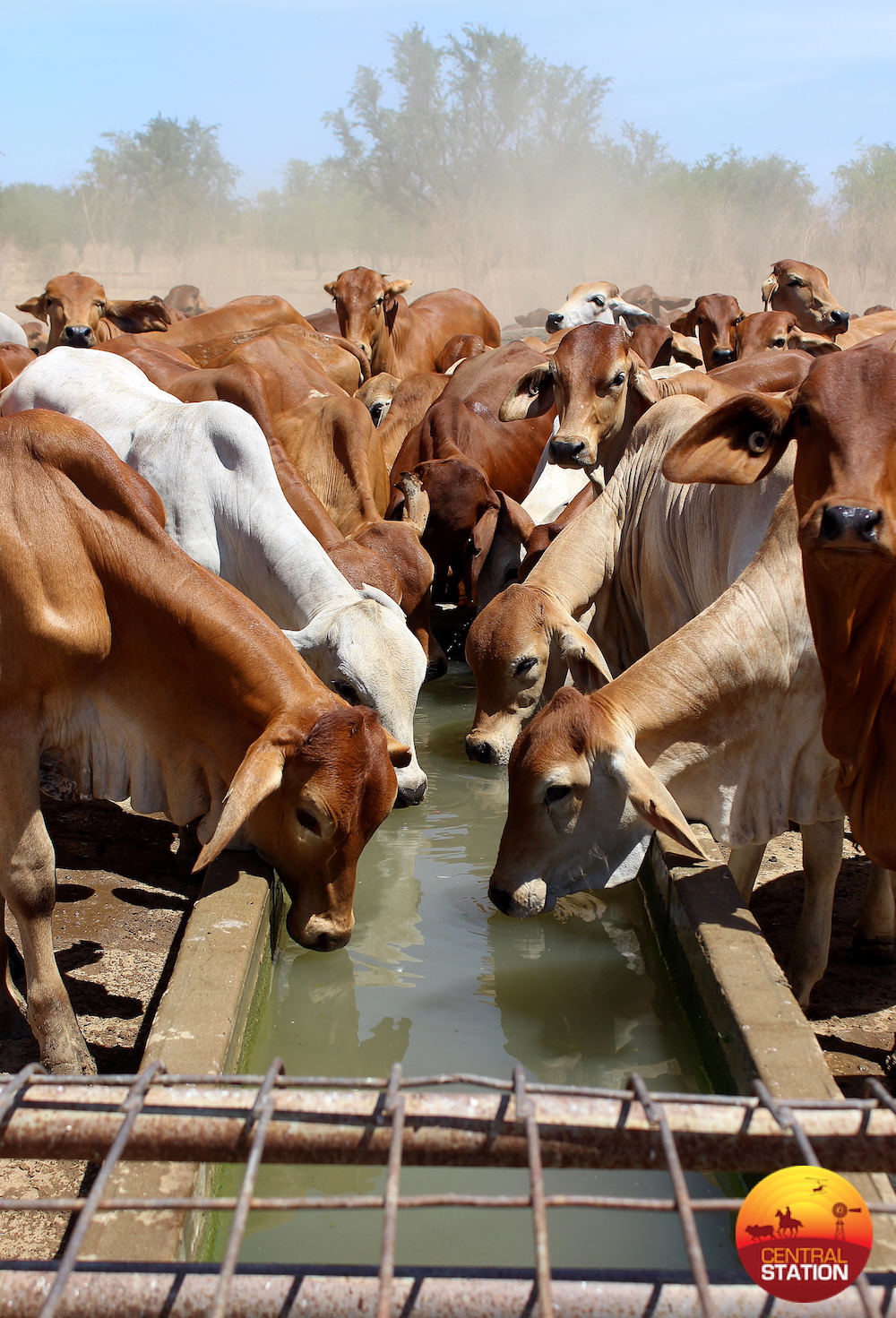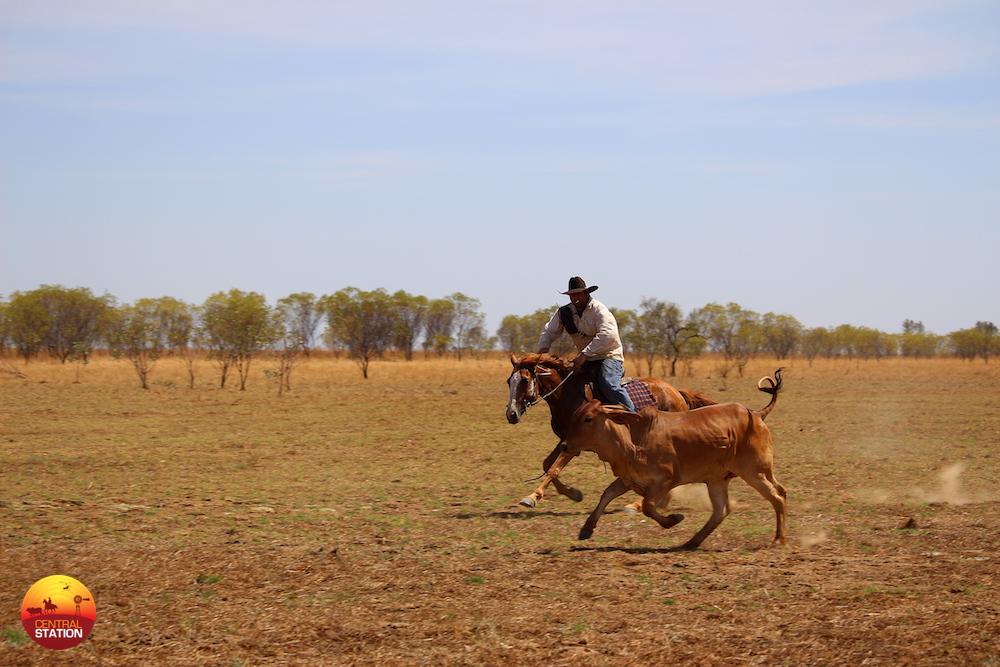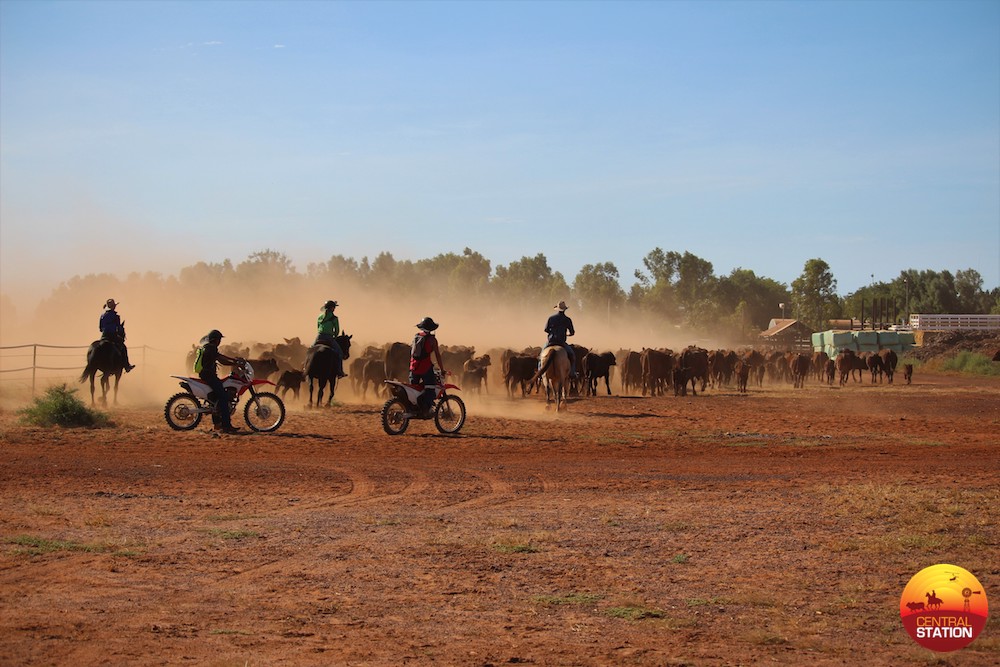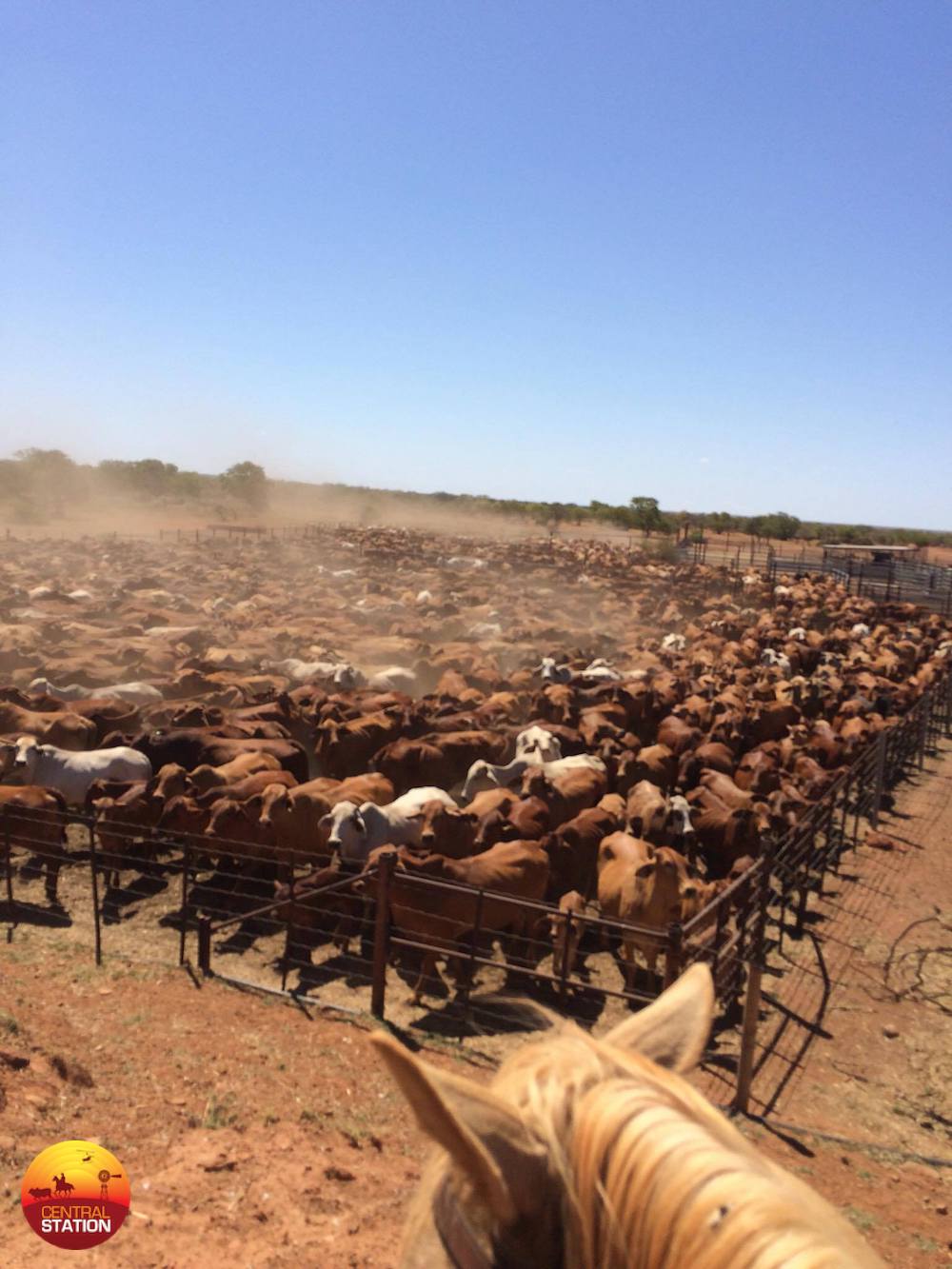My first muster
Written by Emma Moss
Before I share the story about my first muster I want to explain a few things and will continue to do so throughout my story. Many explanations/words will be obvious for most people, but I didn’t know much before I started, and I still have a long way to go. All of which are my interpretation and from my experiences – so may also change person to person as well as station to station. When telling stories, it’s very easy to take the norm in ‘your world’ and forget that someone else may never have experienced anything even remotely similar.
As with most outdoor production systems, everything on cattle stations revolves around the rain. In WA, the wet season, which sees about 90% of the annual rain fall (usually about 1200mm/year), is between November/December and March/April. Mustering kicks off after the wet season when it is dry enough for trucks to drive in and out and dry enough to drive the horse truck/motorbikes to the starting point of the muster. The main purposes for mustering is to:
- Vaccinate all animals against various diseases
- Draft (sort) cows into groups depending on weight and age
- Some to be preg tested to see if the station will keep her for another year or to sell her if she isn’t a good breeder/getting old
- Draft weaners (calves old enough to take off mum’s milk, most likely to be sold)
- Reselect bulls and for some stations take the bulls out
Depending on the manager, bulls can be selected based on age, build, temperament etc.
Some places only put bulls in the paddock seasonally. With the aim the cows are having calves during the wet season – when there is the most amount of grass and therefore easier for her to feed her baby.
These are generally the ‘first round’ objectives. Some stations also do a ‘second round’ later in the year to wean older calves so that mum doesn’t have 2 babies or so she has a good chance of getting fat over the wet. Some places also brand, desex the males, vaccinate and tag calves and return them to their mother as it saves time when weaning and is arguably easier for the calf to recover. Second round also helps bring in any cattle missed in the first muster – some cattle hide, are missed in the paddock or left out of the muster because they have a small calf.
I am very happy that I intermittently kept a diary at Nerrima. It is amazing how many little details I forget and how much it makes me smile reading over it. As much as I am embarrassed about my writing skills and poor vocabulary – I will share some parts in it. They were, after all, my exact feelings at the time.
“I just had my first muster today and I loved it. It was hard work and bloody hot but so exciting. I don’t think my heart has raced that much for such a long period of time before. I learnt a lot about moving cattle and positions on the mob. I chased a few escapees too which was awesome. My god I have a lot to learn”.
Everything was so new to me. At the start of the muster all the cattle were pushed into a watering square and we practiced moving them around a bit. I was the only first year in our camp (stock camp – group of workers) which was very lucky both for me and our head stockwoman – only one semi useful person around the mob and the rest knew what they were doing. And lucky for me because I had a camp full of teachers.
The way we mustered was called coacher mustering. Cattle will mob up more easily at watering points and it is a place they will go naturally when being pushed by a chopper. For this paddock (and my first muster ever) 2 choppers went out before the horses to the initial watering point and split the cattle in half, pushing them to a watering point on opposite sides of the paddock. One mob, the coacher mob, will then be blocked up by the horses. By blocking them up (making them stand still all together) and moving them around a bit they understand (from previous training and pressure/release techniques) that being in the mob is the ‘safe place’ and that the horses control the speed. The other mob is pushed up the fence-line by the chopper with a bike to help push them along. Once decided that both riders and cattle are ready, the mob is walked to the yards – often up a fence-line. Whilst the cattle are walking along, more cattle are ‘fed into’ the mob.
I was on the tail, I think that’s often the rookie position. With the help of the person on the flank/wing, it’s probably the easiest to get the hang of. Especially if the cattle don’t have any problems in moving forward. It was just so damn cool having over 1000 head cattle in front of us rolling up and down hills. Sometimes ducking off into the creek or trying to sneak out into the scrub. I had been given a mustering crash course but still didn’t really know what to expect. I certainly underestimated the hours, length of the walk, numbers of cattle (AND FLIES!) and the amount of dust. No matter how much reading and asking I don’t think mustering to that scale can be fully understood until experienced. It’s not just a job necessary for cattle production, but it’s also a feeling.
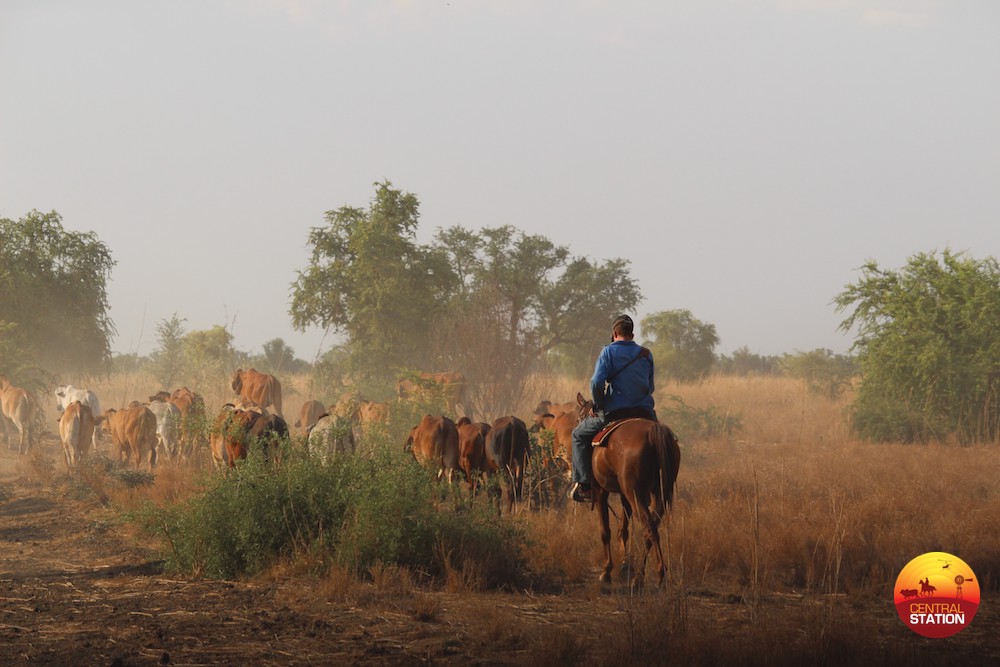
On the tail at Blina Station.
Until you have experienced it yourself, you will realise that there is no other feeling like it. Having the noise of the choppers in the background, people talking on the radio and looking over a huge mob amongst dust, being ready for anything. I think the feelings can be easily forgotten once having a few musters under your belt. The feeling of so many nerves, excitement and apprehension. Those feelings create appreciation for what is going on around you and it’s a pity sometimes that we, as humans, often stop appreciating things once we get used to them. I get a bit sentimental sometimes but I guess it does help me take more in. This is also why writing in a diary is good.
I felt like the fence-line was endless, but I started to get the hang of things. This was mainly because I had absolutely no idea what to expect, what was ahead and what was ‘normal’. Once in the laneway, I had one of my biggest “holy sh!t, this is so cool” moments ever for that year. A couple thousand cattle stood in front of us, 2 choppers behind us, everything a bit more tired now but we had all swallowed enough dust and flies to sustain us. We had a drink (cattle, horses and riders) and had a quick break with the cattle locked in the first part of the laneway. For a very long way in front of me was a sea of mostly red Brangus (Brahman/Angus cross) cattle. But again, there was a long time to go, but I had no idea.
Drink time.
Unless I wrote it in my diary, I would have forgotten my 2 biggest concerns whilst mustering that day as they all very quickly become the ‘norm’. 1 – THE FLIES. I remember my arms were black from flies. My horse didn’t really appreciate them either so was throwing her head a bit and didn’t want to stand still. In fact, the flies were so much of a concern, I radioed through the head stockwoman. I don’t know what she was going to do about it, but I thought she might have something to help. Everyone was very nice to me and said nothing about it, but now I know that they all would have had a little smirk on their faces. ‘God if she finds the flies hard, is she even gonna make it through the year?’ Zarrah pretty well told me to ignore it and get over it. And that I did, now I don’t really even notice the flies – and if I do, I don’t complain.
My second main concern was how to navigate through all the scrub. Along the fence line was graded, so while the mob stuck to it, there were no worries. But more often than not the cattle, and particularly weaners, will wonder off sometimes running, sometimes walking. Between ant hills and spinifex (can only be jumped or dodged) and wattle and mimosa trees (can maybe be ducked under or again dodged), it wasn’t exactly a smooth path. I had absolutely no idea how the hell I would get out of a walk on my horse through it let alone chase a cow back into the mob. I think that’s pretty standard for anyone for the first time seeing it. Very frustrating for all others involved who have mastered the skill of going flat stick and avoiding most things.
“I feel so useless trying to get some stuff (cattle) back. No one’s really sworn at me yet, but I can tell they’re annoyed at me. I just don’t get how they go through everything so quickly. Jacob and Kit just canter straight away and bring anything back before a couple minutes. Charlotte (my horse for the muster) will jump stuff but there’s a lot of pretty branches to duck under. I guess I’ll get there.”
Bring them back to the mob.
I now realise that most paddocks at Nerrima weren’t even that thick in most places. Last year we went through some very dense brigalow along creeks in the Pilbara and ridiculously thick wattle, just out of Derby, which really put things in perspective for me. You know that when you can’t even see the mob until they’re pretty well next to you, that it’s thick.
So, my two main worries are now something I hardly notice and probably would have forgotten about if I didn’t write them down. By the laneway, the flies weren’t bothering me as much. I thought that because we were near the laneway, we were near done. I was wrong.
In majority of yard systems there is a long way before the entry into the yards. Each laneway varies in length and width depending on cattle numbers and management decisions. The laneway serves a few purposes. The main being to make ‘yarding up’ (putting the cattle into the yards and shutting the gate so they stay in there) easier. Often cattle can be difficult to ‘yard up’ however if there is a laneway, it helps all involved as you have more control of the cattle as there is less space for them to run away – the easiest place to go is into the yards. Laneways also allow access to the yards through many paddocks, meaning less fencing and cattle flowing better. Like all training of animals, pressure/release is used. Pressure from behind, release when they go into the yard. Additionally, when walking cattle out of the yards back to their paddock, a laneway can help make it a ‘controlled’ walk home, keeping all the mob together – particularly younger calves.
Cattle behavior depends a lot on breeding and previous handling. There are many schools of thought as to how stock should be handled and the one we followed as much as possible is referred to as ‘low stress stock handling’. Typically, Brahmans are hotter headed when compared to most breeds, similar to probably Merinos of sheep and Thoroughbreds of horses. However, if they know the pressure will be released when they are flowing as desired, and the yards is a flowing, smooth in and out experience, their reactions to humans and horses should reflect that. Everything is obviously a lot more complicated than that, older cattle can be cranky, bulls will have had enough and having so many different handlers as ringers change through the years, all adds to the dynamics.
We were mustering one of our bigger paddocks so instead of keeping all the cattle in a mob we split up so that half of us could walk in front and control the speed and others walk behind and push them along. Again, I was on the tail. Boy did I underestimate the length of the laneway! It was a day full of learning and trying to do everything as right as I knew how. Plus we had been working about 11 hours and up for 12, I was tired and still no idea what to expect.
Towards the end of the muster sometimes the calves lose their mums and hang at the back of the mob. There are a few things that can be done to avoid this: Block up (stop the cattle and keep them in a mob) regularly so the mums can find their babies again, leave the cows with younger calves in the paddock, and not push the tail too hard that the cows can’t come back and find their babies. Even still, it’s a pretty normal thing to happen. My number one job was to keep all the babies moving – not that easy!
The laneway was split into 4 parts. The leaders opened the gates and kept the cattle coming and us on the tail closed the gates to stop anything from running back. Finally, in the last section of the laneway, the yards in our sight (well not really but if the dust wasn’t in the way we could have seen them). By this stage I was off my horse, leading her and pushing some calves. They kept trying to go under the fence or get stuck between the fence and gate. I walked for easily a kilometre. I was told to jump back on my horse now that we were in the last section. I wasn’t sure really what was about to happen.
Putting them in the yard.
The cattle slowly started filing into the yards. I thought, “wow this is cruisey”. Lesson learnt that day: that ‘cracker’ (crazy/naughty/not so level headed) cows wait at the back. Often, they’ll give it all they’ve got to not get into those yards. Another adrenaline boost as we started to block cows again, canter around and move our horses side to side to stop anything from passing us. Wide eyed, exhilarated, tired, dusty and thirsty we finally shut the gates. Walking the short walk to the horse yards was amazing. I had experienced and seen so many firsts and luckily for me, I had many more to come.
I’m writing this story from the kitchen table at home. Getting ready to go back to uni next week. The more I think about the Kimberley and my time Jillarooing, the more I miss it. It’s hard work and there’s some crap days, but reminiscing I really realise – appreciate all the good and write it in a diary when you can!
Overlooking the cattle.

